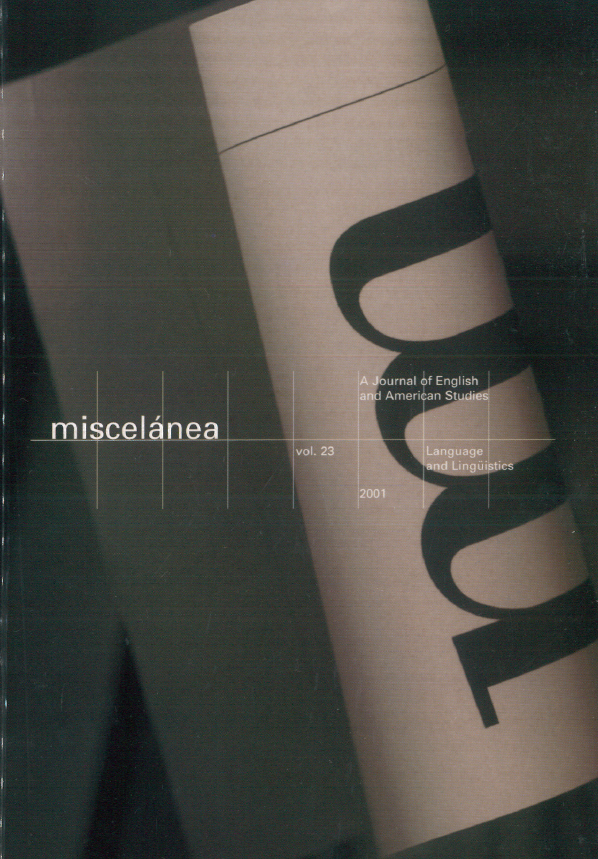The Role of Semantic Relations in the Creation of Metonymic Mappings
DOI:
https://doi.org/10.26754/ojs_misc/mj.200110533Keywords:
metonymy, polysemy, semantic network, relational arch, reversibilityAbstract
In this paper I argue that the set of semantic relations put forward for the construction of propositional meaning by Ruiz de Mendoza (1996) can also be used to define the kinds of relationship that are established between the source and target domains of metonymies. Furthermore, we contend that it is possible to develop a typology of metonymic mappings which is based on this relational system and offer a programmatic classification of metonymy according to this criterion. Finally, we observe that the relationship between metonymic mappings and semantic relations is also useful in dealing effectively with polysemy. Thus, all the different senses of many words can be related by calling upon metonymies which exploit different relations.
Downloads
References
BARCELONA, Antonio. (ed.). 2000. Metaphorand Metonymy at the Crossroads. Berlin/New York: Mouton de Gruyter.
BRUGMAN, Claudia. 1981. “Story of OVER: Polysemy, Semantics and the Structure of the lexicon. New York / London: Garland.
DÍEZ VELASCO, Olga I. 2000. “A Cross-Linguistic Analysis of the Nature of Some Hand Metonymies in English and Spanish”. Atlantis 22 (2):51-67.
DIRVEN, René. 1993. “Metonymy and Metaphor: Different Mental Strategies of Conceptualisation”. Leuvense Bijdragen 82: 1-25.
FAUCONNIER, Gilles. 1985. Mental Spaces. Cambridge, Mass.: MIT Press.
HALLIDAY, M. A. K. 1994. An Introduction to Functional Grammar. London: Edward Arnold.
JAKOBSON, Roman. 1971. Selected Writings, Vol. 2. Word and language. The Hague: Mouton.
KÖVECSES, Zoltan and Günter RADDEN. 1998. “Metonymy: Developing a Cognitive Linguistic View”. Cognitive Linguistics 9 (1): 37-77.
LAKOFF, George. 1987. Women, Fire, and Dangerous Things: What Categories Reveal About the Mind. Chicago: University of Chicago Press.
LAKOFF, George and Mark JOHNSON. 1980. Metaphors We Live By. Chicago: University of Chicago Press.
LEITE, Naomi. 1994. “Master Metonymy List”. Berkeley: Unpublished Draft.
PANTHER, Klaus-Uwe and Linda THORNBURG. 2000. “The EFFECT FOR CAUSE Metonymy in English Grammar”, In Barcelona, A. (ed.): 215-332.
RUIZ DE MENDOZA IBAÑEZ, Francisco. J. 1996. “Semantic Networks in Conceptual Structure”. EPOS, Revista de Filología, UNED 12: 339-356,
—. 1997. “Cognitive and Pragmatic Aspects of Metonymy". Cuadernos de Filología Inglesa. 6 (2): 161-178.
—. 1999a. Introducción a la Teoría Cognitiva de la Metonimia. Granada: Método Ed.
—. 1999b. “From Semantic Underdetermination via Metaphor and Metonymy to Conceptual Interaction”. Essen: LAUD Nº 492.
—. 2000. “The Role of Mappings and Domains in Understanding Metonymy”. In Barcelona, A. (ed.): 109-132.
RUIZ DE MENDOZA IBAÑEZ, Francisco J. and Lorena PÉREZ HERNÁNDEZ. (2001). “Metonymy and the Grammar: Motivation, Constraints and Interaction”. Language and Communication 21: 321-357.
STERN, Gustaf. 1931. Meaning and Change of Meaning. Bloomington: Indiana U. P.
TAYLOR, John R. 1989. Linguistic Categorization. Prototypes in Linguistic Theory. Oxford: Clarendon.
ULLMANN, Stephen. 1962. Semantics: An Introduction to the Science of Meaning. Oxford: Blackwell.
UNGERER, Friedrich and Hans-Jorg SCHMID. 1996. An Introduction to Cognitive Linguistics. New York: Longman.
Downloads
Published
Issue
Section
License
Copyright (c) 2001 Olga Isabel Díaz Velasco

This work is licensed under a Creative Commons Attribution-NonCommercial 4.0 International License.


